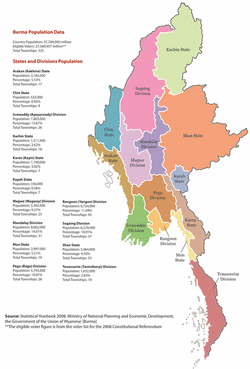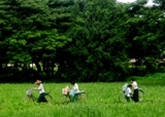
Burma multi-party political landscape is one of the most diverse in the world. In the last general elections, there were more than 20 political parties in the race, and currently more than 10 political parties have their representatives in the national parliament. Democratically speaking-notwithstanding difference in resources endowment and organization effectiveness-the electoral landscape in Burma looks relatively inclusive and promising as citizens have more choices to choose their preferred candidates when they go to the polls.
Looking at them on the surface, Burma seems to offer more options than the U.S because the latter offers only two political parties for 330 million citizens while the former has more than 20 parties for just 60 million people. Out of the 20 or so political parties in Burma, more than half of them are ethnic-based parties. One would assume that ethnic parties would have many seats in the parliament because they are the most numerous in term of numbers. But unfortunately this is not the case.
Currently only about 10 percent of the total national parliamentary seats belong to ethnic-based parties although ethnic groups represent almost forty percent of Burma’s population. Additionally, many ethnic political parties exist in name only and have no representatives at the national level. A major problem that lies at the heart of this inadequate representation for ethnic political parties in the national parliament is the majority or winner-take-all electoral system.
Burma’s current electoral system tends to favor mainstream and established political parties such as USDP or NLD because in a winner-take-all system the party with the most votes, regardless of percentage they receive, win the seat. This means that ethnic parties – which tend to be smaller and weaker in term of funding and resources – will end up not winning seats even if they manage to secure many votes but not enough to claim the majority. For example, an ethnic party in Karen or Shan States could receive a substantial amount of votes in many constituencies it contests but still end up not winning any seats if it fails to secure a majority. As a result, they are less likely to have any representation in parliament in spite of their relative support in some parts of the country. To remedy this disparity and make the system fairer, Proportional Representation System or a mixture of some sort would be a favorable choice for smaller and ethnic political parties.
Under a Proportional Representation (or PR) system, parties are allocated seats proportional to percentage of votes they receive in the elections regardless of a majority or not. In this respect, ethnic political parties will have more chance of gaining seats and receiving equal share of representation in the parliament. In the 2010 general elections, it is estimated that many ethnic political parties have won a substantial number of votes in areas where they contested but not enough majority to win the seat. As a consequent, many of them have to sit outside the parliament.
On the other hand, some of the ethnic parties that secure seats in the national parliament are also underrepresented because they garnered substantial support but not enough votes to claim the majority in many constituencies they contested. Given that the National League for Democracy is certain to compete in 2015 general elections, the race will be a lot more competitive and ethnic parties will find it a lot harder to compete than the previous elections. As democratic and reform process continue to evolve, to level the playing field and improve the chance of ethnic parties gaining more seats and having fairer representation in the parliament, it’s imperative that Burma explores, and if possible, adopts an electoral system that awards seats according percentage of votes a party receive.
Posted by Greh Moo
Looking at them on the surface, Burma seems to offer more options than the U.S because the latter offers only two political parties for 330 million citizens while the former has more than 20 parties for just 60 million people. Out of the 20 or so political parties in Burma, more than half of them are ethnic-based parties. One would assume that ethnic parties would have many seats in the parliament because they are the most numerous in term of numbers. But unfortunately this is not the case.
Currently only about 10 percent of the total national parliamentary seats belong to ethnic-based parties although ethnic groups represent almost forty percent of Burma’s population. Additionally, many ethnic political parties exist in name only and have no representatives at the national level. A major problem that lies at the heart of this inadequate representation for ethnic political parties in the national parliament is the majority or winner-take-all electoral system.
Burma’s current electoral system tends to favor mainstream and established political parties such as USDP or NLD because in a winner-take-all system the party with the most votes, regardless of percentage they receive, win the seat. This means that ethnic parties – which tend to be smaller and weaker in term of funding and resources – will end up not winning seats even if they manage to secure many votes but not enough to claim the majority. For example, an ethnic party in Karen or Shan States could receive a substantial amount of votes in many constituencies it contests but still end up not winning any seats if it fails to secure a majority. As a result, they are less likely to have any representation in parliament in spite of their relative support in some parts of the country. To remedy this disparity and make the system fairer, Proportional Representation System or a mixture of some sort would be a favorable choice for smaller and ethnic political parties.
Under a Proportional Representation (or PR) system, parties are allocated seats proportional to percentage of votes they receive in the elections regardless of a majority or not. In this respect, ethnic political parties will have more chance of gaining seats and receiving equal share of representation in the parliament. In the 2010 general elections, it is estimated that many ethnic political parties have won a substantial number of votes in areas where they contested but not enough majority to win the seat. As a consequent, many of them have to sit outside the parliament.
On the other hand, some of the ethnic parties that secure seats in the national parliament are also underrepresented because they garnered substantial support but not enough votes to claim the majority in many constituencies they contested. Given that the National League for Democracy is certain to compete in 2015 general elections, the race will be a lot more competitive and ethnic parties will find it a lot harder to compete than the previous elections. As democratic and reform process continue to evolve, to level the playing field and improve the chance of ethnic parties gaining more seats and having fairer representation in the parliament, it’s imperative that Burma explores, and if possible, adopts an electoral system that awards seats according percentage of votes a party receive.
Posted by Greh Moo




 RSS Feed
RSS Feed

